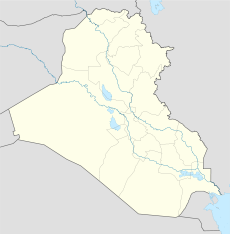- Muthenna Air Base
-
Muthenna Airbase
FOB Headhunter
Camp IndependenceCoordinates 33°19′36″N 044°22′05″E / 33.32667°N 44.36806°E Muthenna Air Base is a former Iraqi Air Force base in the Al-Anbar Governorate of Iraq. It was captured by Coalition forces during Operation Iraqi Freedom in 2003.
Overview
Baghdad/Muthenna was an Iraqi military facility west of the center of Baghdad. It consisted of one 3,000 m asphalt/concrete runway sited in a developed industrial/residential area.
The base was one of several Iraqi Air Force airfields in the mid-1970s which were re-built under project "Super-Base" in response to the experiences from Arab-Israeli wars in 1967 and 1973.
Originally, 13 airfields were re-built by British contractors, and on all of them also a number of hardened aircraft shelters was built. Subsequently companies from Yugoslavia - previously engaged in building bridges in Iraq - became involved. Due to their specific construction of these airfields - which included taxi-ways leading right out of Hardened Aircraft Shelters (HAS) and laid diagonally to the runways - they became known as "Trapezoids" or "Yugos".
The facilities were divided into two categories: "surface" and "underground". The "surface" facilities were actually the "softest", and included maintenance hangars of metal construction, and HAS of concrete construction. In total, the Yugoslavs have built no less but 200 HAS on different airfields in Iraq during the 1980s.
The protection of each HAS consisted of one meter thick concrete shells, reinforced by 30 cm thick steel plates. There was only one entrance and this was covered by sliding doors, made of 50 cm thick steel armoured plate and concrete. The HAS' were usually built in small groups - seldom more than five, with each group sharing the same water and power supply, besides having own backup gasoline-powered electrical generator, and each HAS being equipped with a semi-automatic aircraft-refuelling system.
In addition, underground facilities that could shelter between four and ten aircraft on average were constructed. In order to build these the Yugoslavs used equipment and construction techniques identical to that use in underground oil-storage depots, additionally conealing the extension and the true purpose of the whole project. The underground facilities were all hardened to withstand a direct hit by a tactical nuclear bomb, buried up to 50 meters bellow the ground and consisted of the main aircraft "hangar" (consisting of two floors in several cases, connected by 40ts hydraulic lifts), connected with operations, maintenance, and logistical facilities via a net of underground corridors.
It was a highly important airfield, with the HQs of the Central- or 1st Air Defence Sector IrAF. Besides, Muthenna was the main base of the No 31 Transport Squadron IrAF, equipped with different transport aircraft flown by several detachments, and the "Special VIP-Squadron" IrAAC, that flew two VIP-configured Westland Commandos, three SA.330 Puma, and several MBB Bo.105 helicopters. It was the home base for Iraqi Air Force transport squadrons and navigation school.
During the 1980s a detachment of two Mi-25s of the 4th Sqn IrAAC, used for armed escort of the VIPs, was frequently based at Muthenna as well, and in 1991 a detachment of the No. 5 Sqn IrAF, equipped with MiG-29s, was based here.
During the 1991 Gulf War, three of Baghdad's 42 targets—Iraqi air force headquarters, Muthenna airfield, and Ba'ath party headquarters—absorbed 20 percent of the effort. The Ba'ath party headquarters were hit with 28 bombs, Iraqi air force headquarters 17, and Muthenna airfield with 25. The 13-story Iraqi air force headquarters building, on the southeast edge of Muthenna airfield, was shown in the first publicly unveiled air strike videotape.
During the Second Gulf War Coalition forces again struck Iraqi Air Force headquarters buildings in central Baghdad, located west of the Tigris River, near the Baghdad/Muthenna airfield. Coalition aircraft struck the buildings with JDAMs. The strike degraded Iraqi Air Force capabilities to command and control Iraqi air assets.
The damage at Muthenna was so extensive that it was subsequently abandoned as a functioning aviation facility.
In mid-September 2004, the facility was designated Camp Independence, with its Arabic translation "Camp Al-Istiqlal". Soldiers at Camp Independence do a great deal of training of Iraqi police and soldiers. These Iraqis live on the airfield in a collection of hangers in very close and uncomfortable quarters.
References
 This article incorporates public domain material from websites or documents of the Air Force Historical Research Agency.
This article incorporates public domain material from websites or documents of the Air Force Historical Research Agency.External links
Categories:- Bases of the United States Air Force in Iraq
- Iraqi Air Force bases
- Bases of the United States Air Force
Wikimedia Foundation. 2010.

